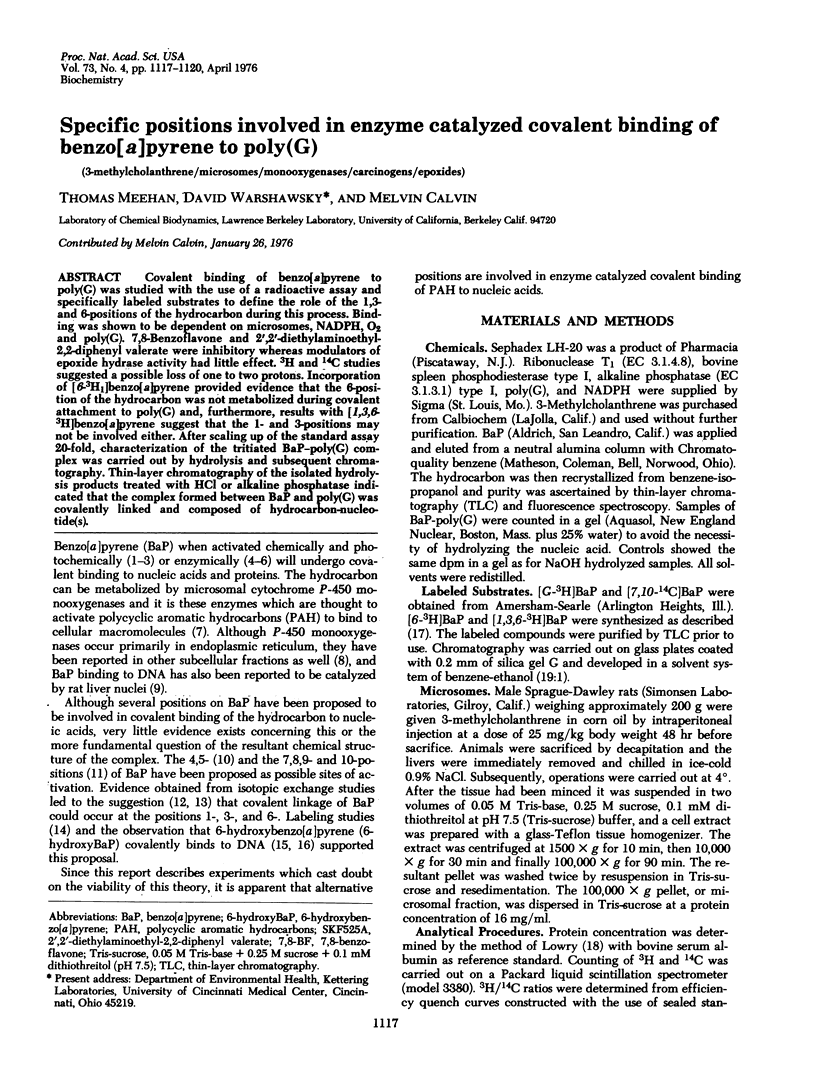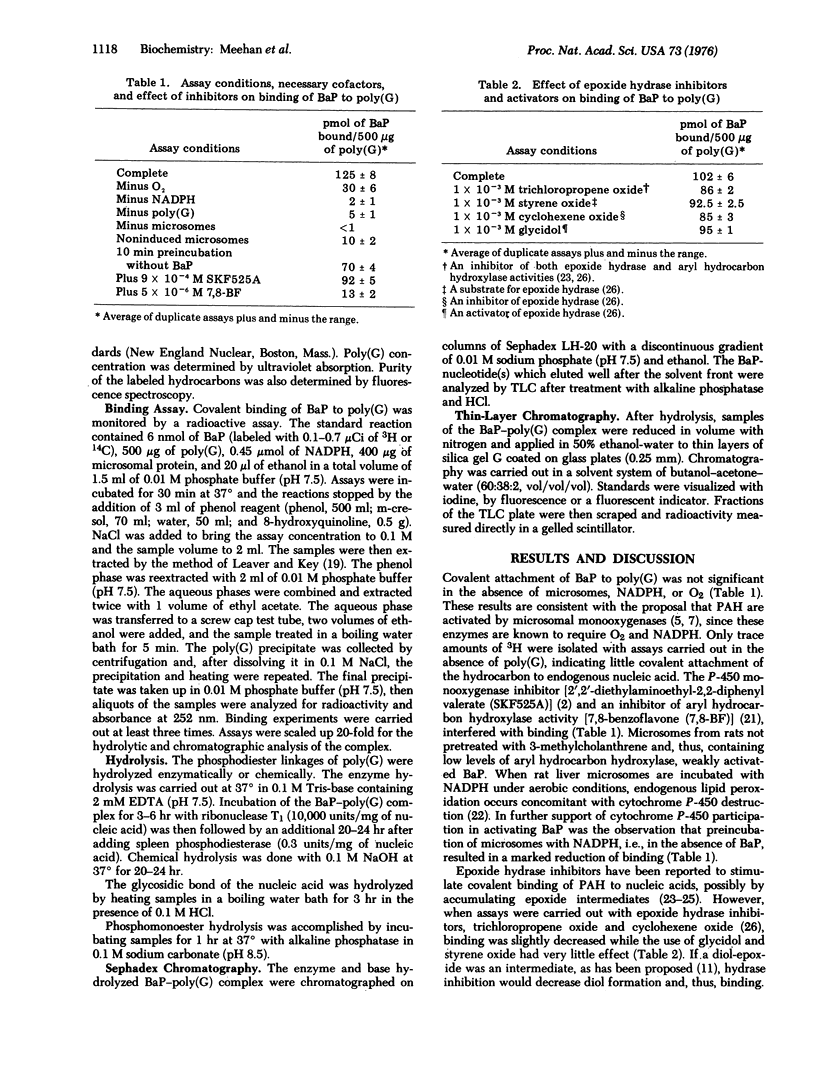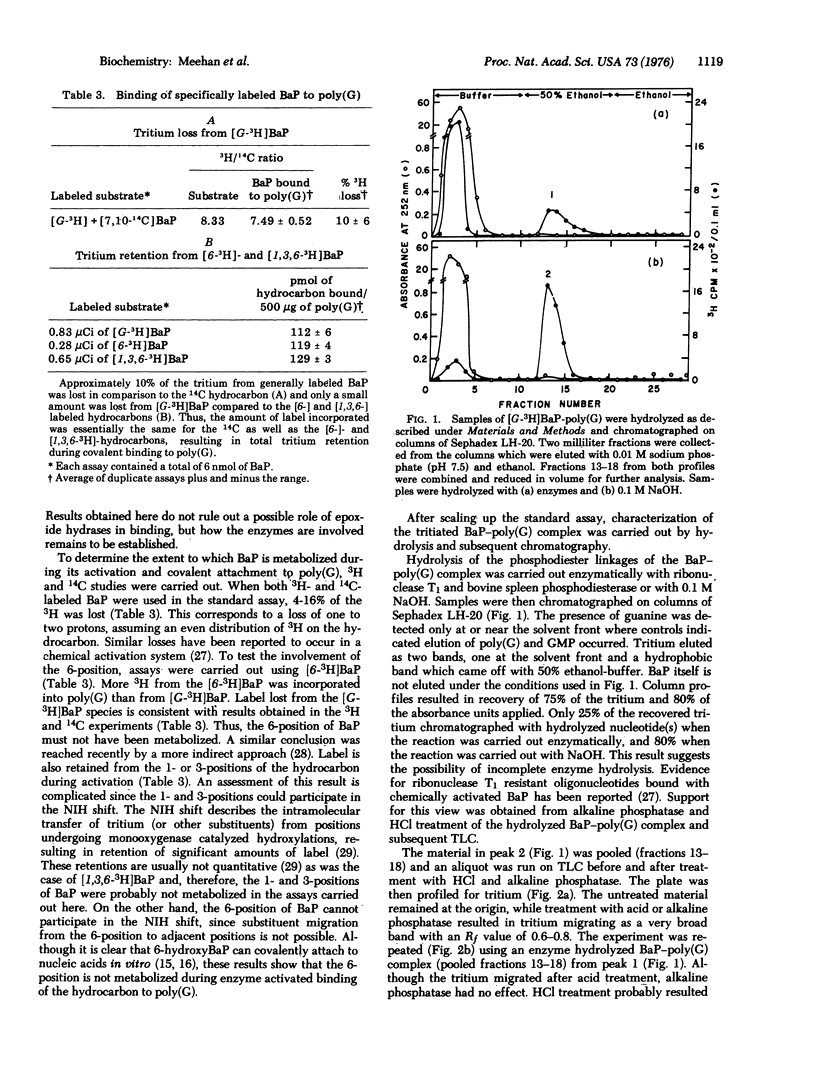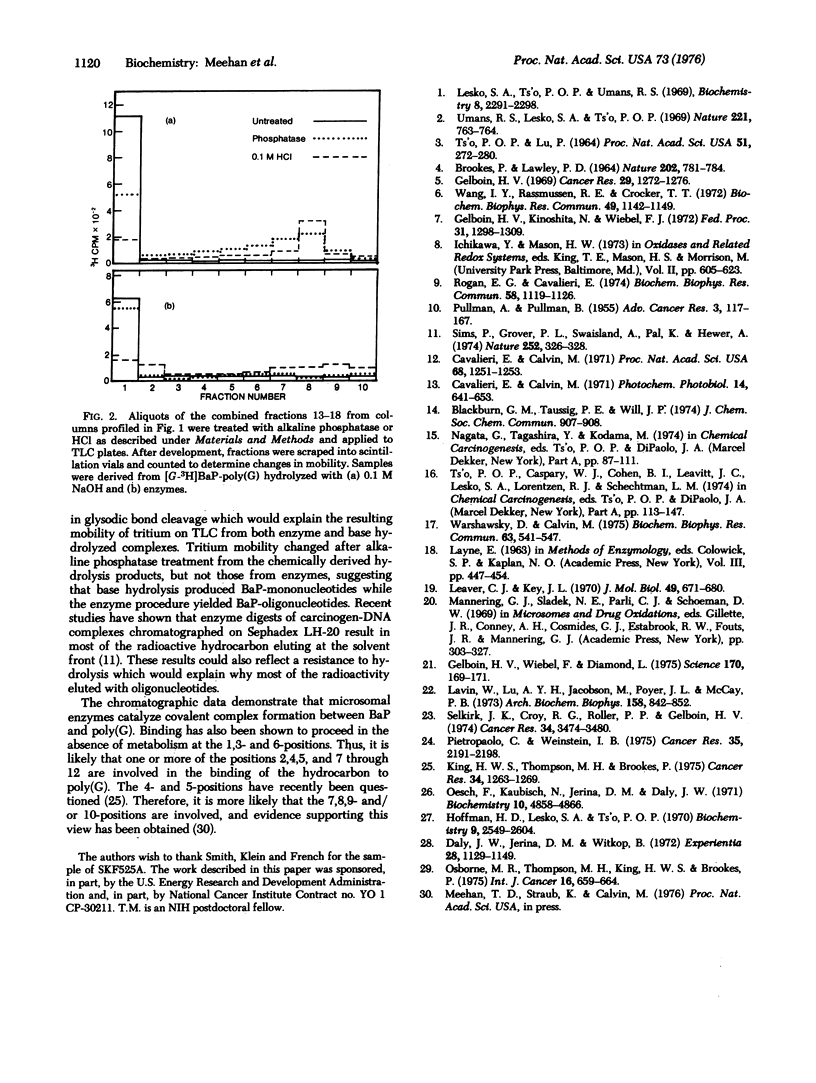Abstract
Covalent binding of benzo[a]pyrene to poly(G) was studied with the use of a radioactive assay and specifically labeled substrates to define the role of the 1, 3- and 6-positions of the hydrocarbon during this process. Binding was shown to be dependent on microsomes, NADPH, O2 and poly(G). 7, 8-Benzoflavone and 2', 2'-diethylaminoethyl-2, 2-diphenyl valerate were inhibitory w.hereas modulators of epoxide hydrase activity had little effect. 3H and 14C studies suggested a possible loss of one to two protons. Incorporation of [6-3H1]benzo[a]pyrene provided evidence that the 6-position of the hydrocarbon was not metabolized during covalent attachment to poly(G) and, furthermore, results with [1, 3, 6-3H]benzo[a]pyrene suggest that the 1- and 3-positions may not be involved either. After scaling up of the standard assay 20-fold, characterization of the tritiated BaP-poly(G) complex was carried out by hydrolysis and subsequent chromatography. Thin-layer chromatography of the isolated hydrolysis products treated with HCl or alkaline phosphatase indicated that the complex formed between BaP and poly(G) was covalently linked and composed of hydrocarbon-nucleotide(s).
Full text
PDF



Selected References
These references are in PubMed. This may not be the complete list of references from this article.
- BROOKES P., LAWLEY P. D. EVIDENCE FOR THE BINDING OF POLYNUCLEAR AROMATIC HYDROCARBONS TO THE NUCLEIC ACIDS OF MOUSE SKIN: RELATION BETWEEN CARCINOGENIC POWER OF HYDROCARBONS AND THEIR BINDING TO DEOXYRIBONUCLEIC ACID. Nature. 1964 May 23;202:781–784. doi: 10.1038/202781a0. [DOI] [PubMed] [Google Scholar]
- Cavalieri E., Calvin M. Molecular characteristics of some carcinogenic hydrocarbons. Proc Natl Acad Sci U S A. 1971 Jun;68(6):1251–1253. doi: 10.1073/pnas.68.6.1251. [DOI] [PMC free article] [PubMed] [Google Scholar]
- Cavalieri E., Calvin M. Photochemical coupling of benzo(a)pyrene with 1-methylcytosine; photoenhancement of carcinogenicity. Photochem Photobiol. 1971 Nov;14(5):641–653. doi: 10.1111/j.1751-1097.1971.tb06202.x. [DOI] [PubMed] [Google Scholar]
- Daly J. W., Jerina D. M., Witkop B. Arene oxides and the NIH shift: the metabolism, toxicity and carcinogenicity of aromatic compounds. Experientia. 1972 Oct 15;28(10):1129–1149. doi: 10.1007/BF01946135. [DOI] [PubMed] [Google Scholar]
- Gelboin H. V. A microsome-dependent binding of benzo[a]pyrene to DNA. Cancer Res. 1969 Jun;29(6):1272–1276. [PubMed] [Google Scholar]
- Gelboin H. V., Kinoshita N., Wiebel F. J. Microsomal hydroxylases: induction and role in polycyclic hydrocarbon carcinogenesis and toxicity. Fed Proc. 1972 Jul-Aug;31(4):1298–1309. [PubMed] [Google Scholar]
- Gelboin H. V., Wiebel F., Diamond L. Dimethylbenzanthracene tumorigenesis and aryl hydrocarbon hydroxylase in mouse skin: inhibition by 7,8-benzoflavone. Science. 1970 Oct 9;170(3954):169–171. doi: 10.1126/science.170.3954.169. [DOI] [PubMed] [Google Scholar]
- Hoffmann H. D., Lesko S. A., Jr, Ts'o P. O. Chemical linkage of polycyclic hydrocarbons to deoxyribonucleic acids and polynucleotides in aqueous solution and in a buffer-ethanol solvent system. Biochemistry. 1970 Jun 23;9(13):2594–2604. doi: 10.1021/bi00815a006. [DOI] [PubMed] [Google Scholar]
- King H. W., Thompson M. H., Brookes P. The benzo(alpha)pyrene deoxyribonucleoside products isolated from DNA after metabolism of benzo(alpha)pyrene by rat liver microsomes in the presence of DNA. Cancer Res. 1975 May;35(5):1263–1269. [PubMed] [Google Scholar]
- Leaver C. J., Key J. L. Ribosomal RNA synthesis in plants. J Mol Biol. 1970 May 14;49(3):671–680. doi: 10.1016/0022-2836(70)90290-1. [DOI] [PubMed] [Google Scholar]
- Lesko S. A., Jr, Ts'o P. O., Umans R. S. Interaction of nucleic acids. V. Chemical linkage of 3,4-benzpyrene to deoxyribonucleic acid in aqueous solution. Biochemistry. 1969 Jun;8(6):2291–2298. doi: 10.1021/bi00834a009. [DOI] [PubMed] [Google Scholar]
- Levin W., Lu A. Y., Jacobson M., Kuntzman R., Poyer J. L., McCay P. B. Lipid peroxidation and the degradation of cytochrome P-450 heme. Arch Biochem Biophys. 1973 Oct;158(2):842–852. doi: 10.1016/0003-9861(73)90580-8. [DOI] [PubMed] [Google Scholar]
- Oesch F., Kaubisch N., Jerina D. M., Daly J. W. Hepatic epoxide hydrase. Structure-activity relationships for substrates and inhibitors. Biochemistry. 1971 Dec 21;10(26):4858–4866. doi: 10.1021/bi00802a005. [DOI] [PubMed] [Google Scholar]
- Osborne M. R., Thompson M. H., King H. W., Brookes P. Retention of tritium during the binding of tritiated benz(a)pyrene to DNA. Int J Cancer. 1975 Oct 15;16(4):659–664. doi: 10.1002/ijc.2910160416. [DOI] [PubMed] [Google Scholar]
- PULLMAN A., PULLMAN B. Electronic structure and carcinogenic activity of aromatic molecules; new developments. Adv Cancer Res. 1955;3:117–169. doi: 10.1016/s0065-230x(08)60919-7. [DOI] [PubMed] [Google Scholar]
- Pietropaolo C., Weinstein I. B. Binding of [3H]benzo(a)pyrene to natural and synthetic nucleic acids in a subcellular microsomal system. Cancer Res. 1975 Aug;35(8):2191–2198. [PubMed] [Google Scholar]
- Rogan E. G., Cavalieri E. 3-Methylcholanthrene-inducible binding of aromatic hydrocarbons to DNA in purified rat liver nuclei. Biochem Biophys Res Commun. 1974 Jun 18;58(4):1119–1126. doi: 10.1016/s0006-291x(74)80259-7. [DOI] [PubMed] [Google Scholar]
- Selkirk J. K., Croy R. G., Roller P. P., Gelboin H. V. High-pressure liquid chromatographic analysis of benzo(alpha)pyrene metabolism and covalent binding and the mechanism of action of 7,8-benzoflavone and 1,2-epoxy-3,3,3-trichloropropane. Cancer Res. 1974 Dec;34(12):3474–3480. [PubMed] [Google Scholar]
- Sims P., Grover P. L., Swaisland A., Pal K., Hewer A. Metabolic activation of benzo(a)pyrene proceeds by a diol-epoxide. Nature. 1974 Nov 22;252(5481):326–328. doi: 10.1038/252326a0. [DOI] [PubMed] [Google Scholar]
- Umans R. S., Lesko S. A., Jr, Ts'o P. O. Chemical linkage of carcinogenic 3,4-benzpyrene to DNA in aqueous solution induced by peroxide and iodine. Nature. 1969 Feb 22;221(5182):763–764. doi: 10.1038/221763a0. [DOI] [PubMed] [Google Scholar]
- Wang I. Y., Rasmussen R. E., Crocker T. T. Isolation and characterization of an active DNA-binding metabolite of benzo(a)pyrene from hamster liver microsomal incubation systems. Biochem Biophys Res Commun. 1972 Nov 15;49(4):1142–1149. doi: 10.1016/0006-291x(72)90332-4. [DOI] [PubMed] [Google Scholar]
- Warshawsky D., Calvin M. Tritium incorporation at specific positions in benzo(a)pyrene. Biochem Biophys Res Commun. 1975 Apr 7;63(3):541–547. doi: 10.1016/s0006-291x(75)80418-9. [DOI] [PubMed] [Google Scholar]


